GROWTH AND DEVELOPMENT OF EARLY CHILDHOOD.
VerifiedAdded on 2022/11/14
|10
|2843
|1
AI Summary
explain about the theories that you are criticizing at first and criticize in the middle and at last do introduction.
- please use simple language so that teacher do not doubt.
- you can use links and put as reference
- answers should relate with question please
Contribute Materials
Your contribution can guide someone’s learning journey. Share your
documents today.

Running head: GROWTH AND DEVELOPMENT OF EARLY CHILDHOOD
Growth and Development of Early Childhood
Name of the Student:
Name of the University:
Author note:
Growth and Development of Early Childhood
Name of the Student:
Name of the University:
Author note:
Secure Best Marks with AI Grader
Need help grading? Try our AI Grader for instant feedback on your assignments.

1GROWTH AND DEVELOPMENT OF EARLY CHILDHOOD
Development of young child entails the emotional, biological and psychological changes
that take place within human beings between the time span of their birth and adolescence, as
he or she progresses from the dependency to increasing autonomy. It is to note that child
development is a continuous process and is a unique course for every children (Cook et al.,
2017). There are several experts in the field of science and medicine who have marvelled for
several years over the different ways in which young children develop. As a response to the
questions related to the things affecting children development, the ages at which development
is susceptible to the external impacts, ways of minimising detriments and maximising the
growth of children, several experts have abounded several theories such as the Psychosocial
Developmental Theory by Erikson, the Moral Understanding Stage Theory by Kohlberg,
the Cognitive Developmental Theory by Piaget, the Attachment Theory by Bowlby and the
Psychosexual Developmental Theory by Freud. This essay shall elaborate on presenting an
essay outlining and critiquing the major developmental theories under the development of
young children.
Child development, that takes place from birth to adulthood, has largely ignored
throughout the human history. Children often were perceived as small versions of adults and
this is why, very little attention was paid to the different advancements in terms of language
usage, physical growth and cognitive abilities that take place at the time of childhood and
adolescence (Boyden, 2015). Interest in this area finally started early during the 20th century,
focusing on the abnormal behaviours among children. Gradually, researchers started being
interested in the other topics like influences on their development and typical child
development. It is to note that child development theories focus on explanation of how
children change and grow over the course of their childhood. These theories revolve around
different aspects of children development like their emotional, social and cognitive growth.
According to Hawkins and Weis (2017), the theories of child development provide a clear
Development of young child entails the emotional, biological and psychological changes
that take place within human beings between the time span of their birth and adolescence, as
he or she progresses from the dependency to increasing autonomy. It is to note that child
development is a continuous process and is a unique course for every children (Cook et al.,
2017). There are several experts in the field of science and medicine who have marvelled for
several years over the different ways in which young children develop. As a response to the
questions related to the things affecting children development, the ages at which development
is susceptible to the external impacts, ways of minimising detriments and maximising the
growth of children, several experts have abounded several theories such as the Psychosocial
Developmental Theory by Erikson, the Moral Understanding Stage Theory by Kohlberg,
the Cognitive Developmental Theory by Piaget, the Attachment Theory by Bowlby and the
Psychosexual Developmental Theory by Freud. This essay shall elaborate on presenting an
essay outlining and critiquing the major developmental theories under the development of
young children.
Child development, that takes place from birth to adulthood, has largely ignored
throughout the human history. Children often were perceived as small versions of adults and
this is why, very little attention was paid to the different advancements in terms of language
usage, physical growth and cognitive abilities that take place at the time of childhood and
adolescence (Boyden, 2015). Interest in this area finally started early during the 20th century,
focusing on the abnormal behaviours among children. Gradually, researchers started being
interested in the other topics like influences on their development and typical child
development. It is to note that child development theories focus on explanation of how
children change and grow over the course of their childhood. These theories revolve around
different aspects of children development like their emotional, social and cognitive growth.
According to Hawkins and Weis (2017), the theories of child development provide a clear
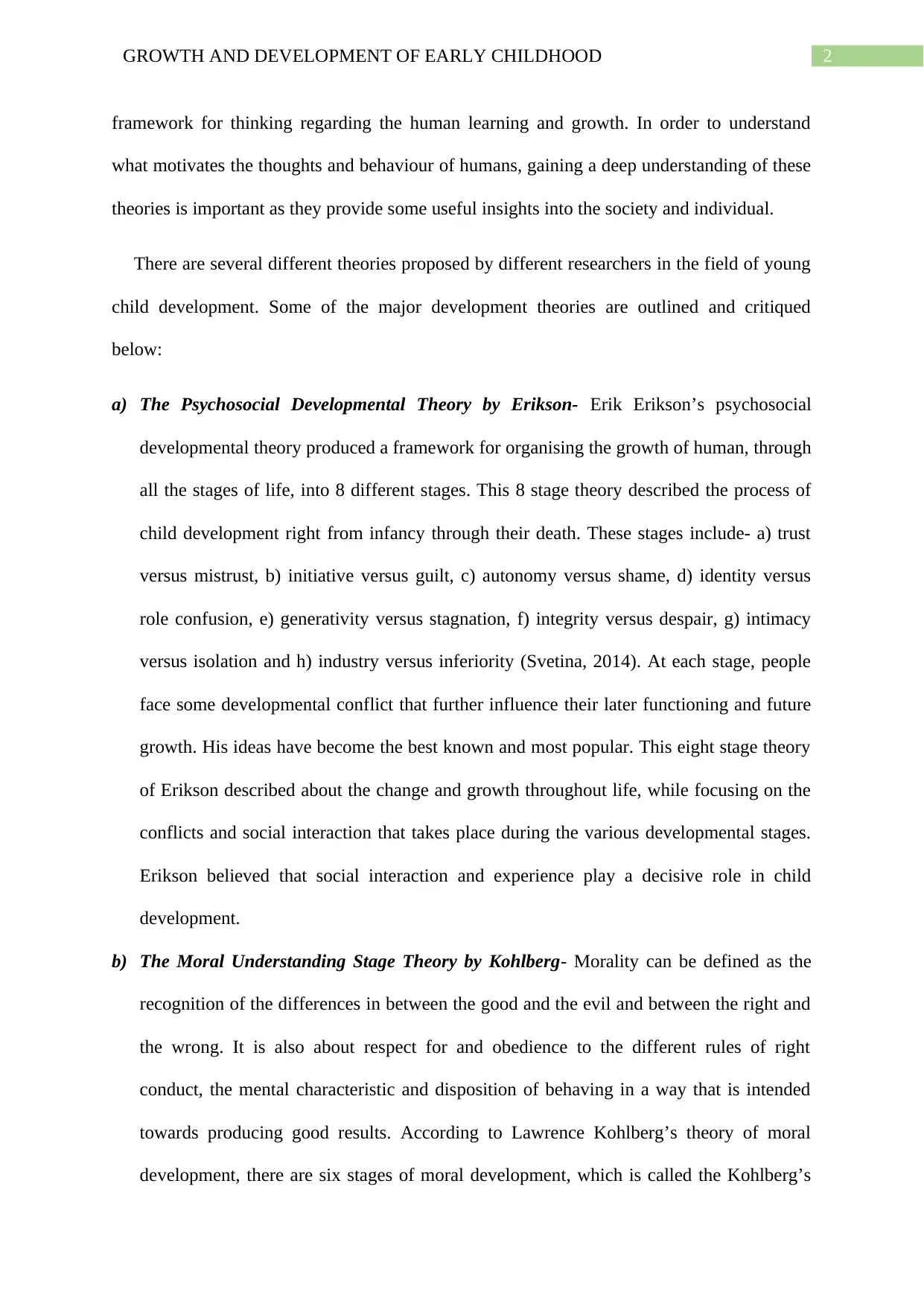
2GROWTH AND DEVELOPMENT OF EARLY CHILDHOOD
framework for thinking regarding the human learning and growth. In order to understand
what motivates the thoughts and behaviour of humans, gaining a deep understanding of these
theories is important as they provide some useful insights into the society and individual.
There are several different theories proposed by different researchers in the field of young
child development. Some of the major development theories are outlined and critiqued
below:
a) The Psychosocial Developmental Theory by Erikson- Erik Erikson’s psychosocial
developmental theory produced a framework for organising the growth of human, through
all the stages of life, into 8 different stages. This 8 stage theory described the process of
child development right from infancy through their death. These stages include- a) trust
versus mistrust, b) initiative versus guilt, c) autonomy versus shame, d) identity versus
role confusion, e) generativity versus stagnation, f) integrity versus despair, g) intimacy
versus isolation and h) industry versus inferiority (Svetina, 2014). At each stage, people
face some developmental conflict that further influence their later functioning and future
growth. His ideas have become the best known and most popular. This eight stage theory
of Erikson described about the change and growth throughout life, while focusing on the
conflicts and social interaction that takes place during the various developmental stages.
Erikson believed that social interaction and experience play a decisive role in child
development.
b) The Moral Understanding Stage Theory by Kohlberg- Morality can be defined as the
recognition of the differences in between the good and the evil and between the right and
the wrong. It is also about respect for and obedience to the different rules of right
conduct, the mental characteristic and disposition of behaving in a way that is intended
towards producing good results. According to Lawrence Kohlberg’s theory of moral
development, there are six stages of moral development, which is called the Kohlberg’s
framework for thinking regarding the human learning and growth. In order to understand
what motivates the thoughts and behaviour of humans, gaining a deep understanding of these
theories is important as they provide some useful insights into the society and individual.
There are several different theories proposed by different researchers in the field of young
child development. Some of the major development theories are outlined and critiqued
below:
a) The Psychosocial Developmental Theory by Erikson- Erik Erikson’s psychosocial
developmental theory produced a framework for organising the growth of human, through
all the stages of life, into 8 different stages. This 8 stage theory described the process of
child development right from infancy through their death. These stages include- a) trust
versus mistrust, b) initiative versus guilt, c) autonomy versus shame, d) identity versus
role confusion, e) generativity versus stagnation, f) integrity versus despair, g) intimacy
versus isolation and h) industry versus inferiority (Svetina, 2014). At each stage, people
face some developmental conflict that further influence their later functioning and future
growth. His ideas have become the best known and most popular. This eight stage theory
of Erikson described about the change and growth throughout life, while focusing on the
conflicts and social interaction that takes place during the various developmental stages.
Erikson believed that social interaction and experience play a decisive role in child
development.
b) The Moral Understanding Stage Theory by Kohlberg- Morality can be defined as the
recognition of the differences in between the good and the evil and between the right and
the wrong. It is also about respect for and obedience to the different rules of right
conduct, the mental characteristic and disposition of behaving in a way that is intended
towards producing good results. According to Lawrence Kohlberg’s theory of moral
development, there are six stages of moral development, which is called the Kohlberg’s
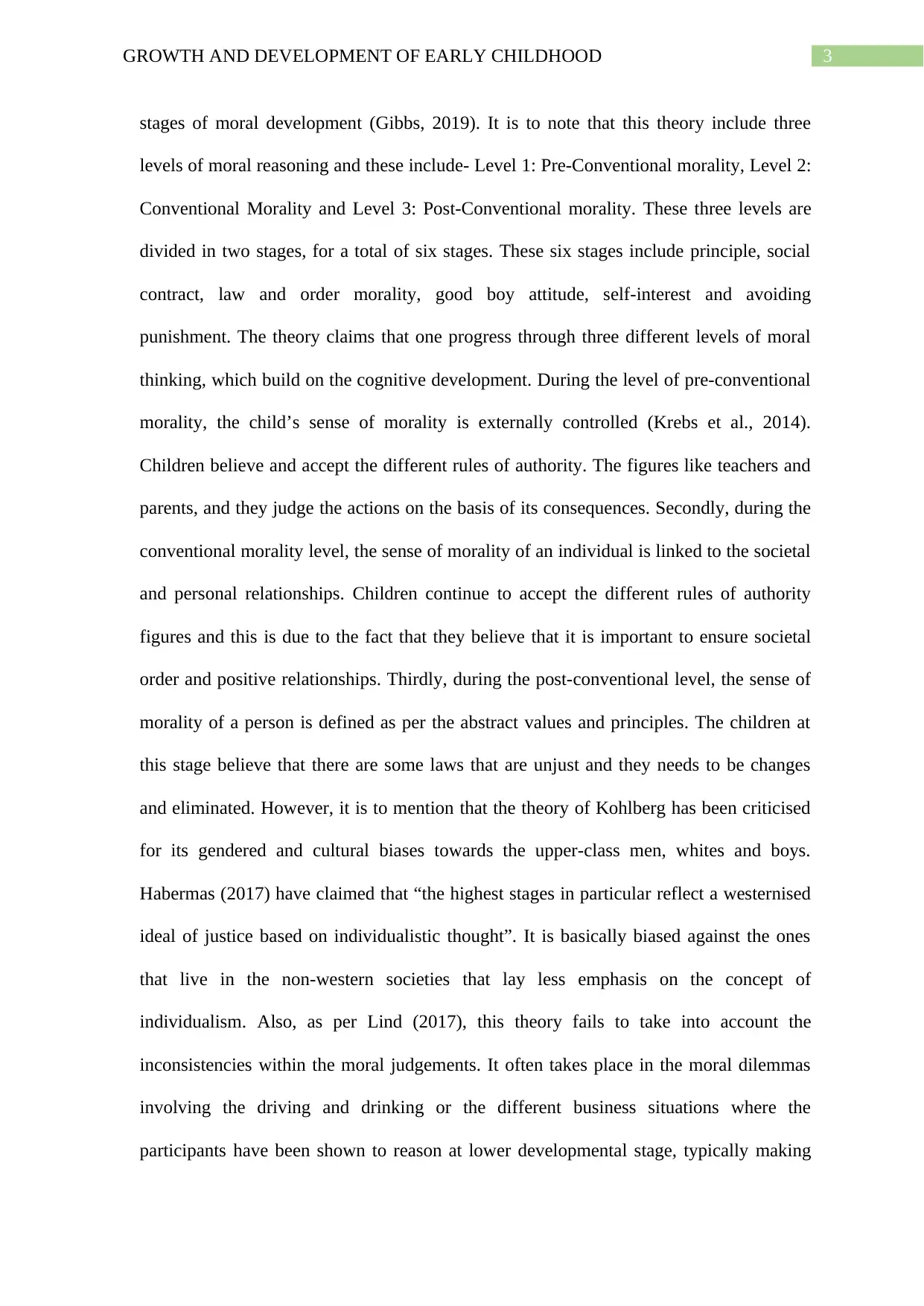
3GROWTH AND DEVELOPMENT OF EARLY CHILDHOOD
stages of moral development (Gibbs, 2019). It is to note that this theory include three
levels of moral reasoning and these include- Level 1: Pre-Conventional morality, Level 2:
Conventional Morality and Level 3: Post-Conventional morality. These three levels are
divided in two stages, for a total of six stages. These six stages include principle, social
contract, law and order morality, good boy attitude, self-interest and avoiding
punishment. The theory claims that one progress through three different levels of moral
thinking, which build on the cognitive development. During the level of pre-conventional
morality, the child’s sense of morality is externally controlled (Krebs et al., 2014).
Children believe and accept the different rules of authority. The figures like teachers and
parents, and they judge the actions on the basis of its consequences. Secondly, during the
conventional morality level, the sense of morality of an individual is linked to the societal
and personal relationships. Children continue to accept the different rules of authority
figures and this is due to the fact that they believe that it is important to ensure societal
order and positive relationships. Thirdly, during the post-conventional level, the sense of
morality of a person is defined as per the abstract values and principles. The children at
this stage believe that there are some laws that are unjust and they needs to be changes
and eliminated. However, it is to mention that the theory of Kohlberg has been criticised
for its gendered and cultural biases towards the upper-class men, whites and boys.
Habermas (2017) have claimed that “the highest stages in particular reflect a westernised
ideal of justice based on individualistic thought”. It is basically biased against the ones
that live in the non-western societies that lay less emphasis on the concept of
individualism. Also, as per Lind (2017), this theory fails to take into account the
inconsistencies within the moral judgements. It often takes place in the moral dilemmas
involving the driving and drinking or the different business situations where the
participants have been shown to reason at lower developmental stage, typically making
stages of moral development (Gibbs, 2019). It is to note that this theory include three
levels of moral reasoning and these include- Level 1: Pre-Conventional morality, Level 2:
Conventional Morality and Level 3: Post-Conventional morality. These three levels are
divided in two stages, for a total of six stages. These six stages include principle, social
contract, law and order morality, good boy attitude, self-interest and avoiding
punishment. The theory claims that one progress through three different levels of moral
thinking, which build on the cognitive development. During the level of pre-conventional
morality, the child’s sense of morality is externally controlled (Krebs et al., 2014).
Children believe and accept the different rules of authority. The figures like teachers and
parents, and they judge the actions on the basis of its consequences. Secondly, during the
conventional morality level, the sense of morality of an individual is linked to the societal
and personal relationships. Children continue to accept the different rules of authority
figures and this is due to the fact that they believe that it is important to ensure societal
order and positive relationships. Thirdly, during the post-conventional level, the sense of
morality of a person is defined as per the abstract values and principles. The children at
this stage believe that there are some laws that are unjust and they needs to be changes
and eliminated. However, it is to mention that the theory of Kohlberg has been criticised
for its gendered and cultural biases towards the upper-class men, whites and boys.
Habermas (2017) have claimed that “the highest stages in particular reflect a westernised
ideal of justice based on individualistic thought”. It is basically biased against the ones
that live in the non-western societies that lay less emphasis on the concept of
individualism. Also, as per Lind (2017), this theory fails to take into account the
inconsistencies within the moral judgements. It often takes place in the moral dilemmas
involving the driving and drinking or the different business situations where the
participants have been shown to reason at lower developmental stage, typically making
Secure Best Marks with AI Grader
Need help grading? Try our AI Grader for instant feedback on your assignments.
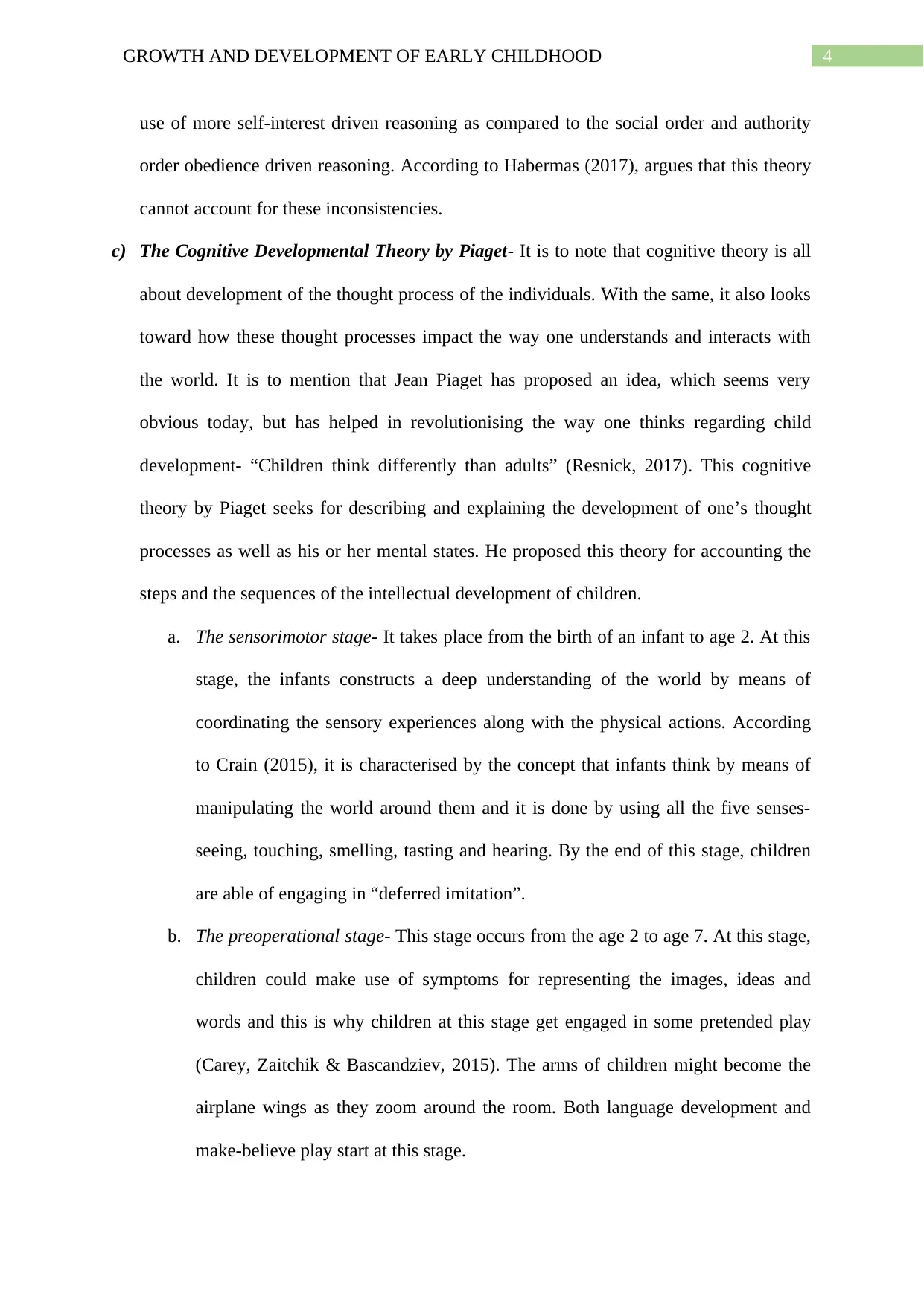
4GROWTH AND DEVELOPMENT OF EARLY CHILDHOOD
use of more self-interest driven reasoning as compared to the social order and authority
order obedience driven reasoning. According to Habermas (2017), argues that this theory
cannot account for these inconsistencies.
c) The Cognitive Developmental Theory by Piaget- It is to note that cognitive theory is all
about development of the thought process of the individuals. With the same, it also looks
toward how these thought processes impact the way one understands and interacts with
the world. It is to mention that Jean Piaget has proposed an idea, which seems very
obvious today, but has helped in revolutionising the way one thinks regarding child
development- “Children think differently than adults” (Resnick, 2017). This cognitive
theory by Piaget seeks for describing and explaining the development of one’s thought
processes as well as his or her mental states. He proposed this theory for accounting the
steps and the sequences of the intellectual development of children.
a. The sensorimotor stage- It takes place from the birth of an infant to age 2. At this
stage, the infants constructs a deep understanding of the world by means of
coordinating the sensory experiences along with the physical actions. According
to Crain (2015), it is characterised by the concept that infants think by means of
manipulating the world around them and it is done by using all the five senses-
seeing, touching, smelling, tasting and hearing. By the end of this stage, children
are able of engaging in “deferred imitation”.
b. The preoperational stage- This stage occurs from the age 2 to age 7. At this stage,
children could make use of symptoms for representing the images, ideas and
words and this is why children at this stage get engaged in some pretended play
(Carey, Zaitchik & Bascandziev, 2015). The arms of children might become the
airplane wings as they zoom around the room. Both language development and
make-believe play start at this stage.
use of more self-interest driven reasoning as compared to the social order and authority
order obedience driven reasoning. According to Habermas (2017), argues that this theory
cannot account for these inconsistencies.
c) The Cognitive Developmental Theory by Piaget- It is to note that cognitive theory is all
about development of the thought process of the individuals. With the same, it also looks
toward how these thought processes impact the way one understands and interacts with
the world. It is to mention that Jean Piaget has proposed an idea, which seems very
obvious today, but has helped in revolutionising the way one thinks regarding child
development- “Children think differently than adults” (Resnick, 2017). This cognitive
theory by Piaget seeks for describing and explaining the development of one’s thought
processes as well as his or her mental states. He proposed this theory for accounting the
steps and the sequences of the intellectual development of children.
a. The sensorimotor stage- It takes place from the birth of an infant to age 2. At this
stage, the infants constructs a deep understanding of the world by means of
coordinating the sensory experiences along with the physical actions. According
to Crain (2015), it is characterised by the concept that infants think by means of
manipulating the world around them and it is done by using all the five senses-
seeing, touching, smelling, tasting and hearing. By the end of this stage, children
are able of engaging in “deferred imitation”.
b. The preoperational stage- This stage occurs from the age 2 to age 7. At this stage,
children could make use of symptoms for representing the images, ideas and
words and this is why children at this stage get engaged in some pretended play
(Carey, Zaitchik & Bascandziev, 2015). The arms of children might become the
airplane wings as they zoom around the room. Both language development and
make-believe play start at this stage.
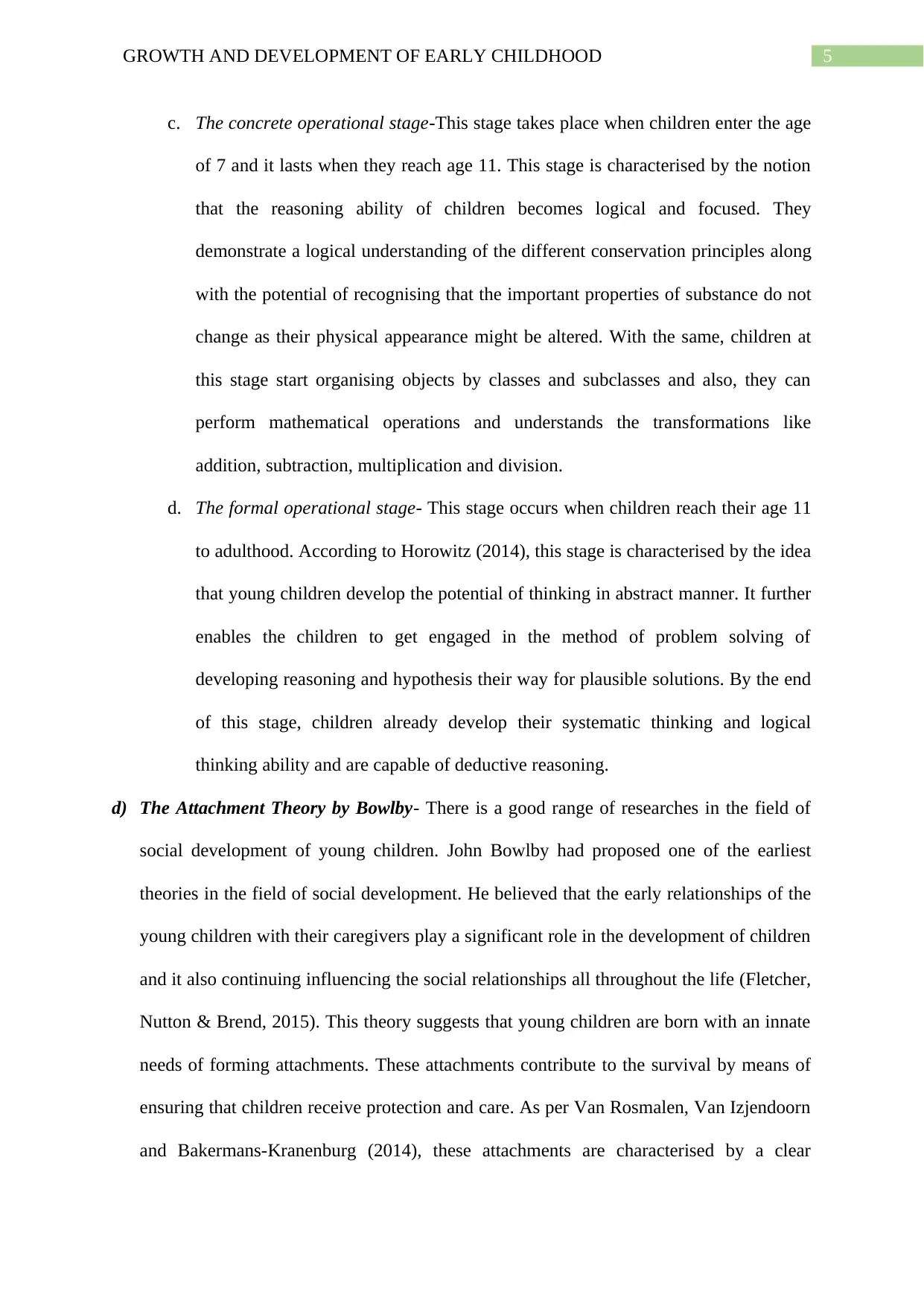
5GROWTH AND DEVELOPMENT OF EARLY CHILDHOOD
c. The concrete operational stage-This stage takes place when children enter the age
of 7 and it lasts when they reach age 11. This stage is characterised by the notion
that the reasoning ability of children becomes logical and focused. They
demonstrate a logical understanding of the different conservation principles along
with the potential of recognising that the important properties of substance do not
change as their physical appearance might be altered. With the same, children at
this stage start organising objects by classes and subclasses and also, they can
perform mathematical operations and understands the transformations like
addition, subtraction, multiplication and division.
d. The formal operational stage- This stage occurs when children reach their age 11
to adulthood. According to Horowitz (2014), this stage is characterised by the idea
that young children develop the potential of thinking in abstract manner. It further
enables the children to get engaged in the method of problem solving of
developing reasoning and hypothesis their way for plausible solutions. By the end
of this stage, children already develop their systematic thinking and logical
thinking ability and are capable of deductive reasoning.
d) The Attachment Theory by Bowlby- There is a good range of researches in the field of
social development of young children. John Bowlby had proposed one of the earliest
theories in the field of social development. He believed that the early relationships of the
young children with their caregivers play a significant role in the development of children
and it also continuing influencing the social relationships all throughout the life (Fletcher,
Nutton & Brend, 2015). This theory suggests that young children are born with an innate
needs of forming attachments. These attachments contribute to the survival by means of
ensuring that children receive protection and care. As per Van Rosmalen, Van Izjendoorn
and Bakermans-Kranenburg (2014), these attachments are characterised by a clear
c. The concrete operational stage-This stage takes place when children enter the age
of 7 and it lasts when they reach age 11. This stage is characterised by the notion
that the reasoning ability of children becomes logical and focused. They
demonstrate a logical understanding of the different conservation principles along
with the potential of recognising that the important properties of substance do not
change as their physical appearance might be altered. With the same, children at
this stage start organising objects by classes and subclasses and also, they can
perform mathematical operations and understands the transformations like
addition, subtraction, multiplication and division.
d. The formal operational stage- This stage occurs when children reach their age 11
to adulthood. According to Horowitz (2014), this stage is characterised by the idea
that young children develop the potential of thinking in abstract manner. It further
enables the children to get engaged in the method of problem solving of
developing reasoning and hypothesis their way for plausible solutions. By the end
of this stage, children already develop their systematic thinking and logical
thinking ability and are capable of deductive reasoning.
d) The Attachment Theory by Bowlby- There is a good range of researches in the field of
social development of young children. John Bowlby had proposed one of the earliest
theories in the field of social development. He believed that the early relationships of the
young children with their caregivers play a significant role in the development of children
and it also continuing influencing the social relationships all throughout the life (Fletcher,
Nutton & Brend, 2015). This theory suggests that young children are born with an innate
needs of forming attachments. These attachments contribute to the survival by means of
ensuring that children receive protection and care. As per Van Rosmalen, Van Izjendoorn
and Bakermans-Kranenburg (2014), these attachments are characterised by a clear

6GROWTH AND DEVELOPMENT OF EARLY CHILDHOOD
motivational and behavioural patterns. Bowlby have claimed that the children who get
consistent care and support from their caregivers are more possibly to develop well-
secured style of attachment and the ones who do not, develop avoidant, disorganised and
ambivalent style.
e) The Psychosexual Developmental Theory by Freud- It is to mention that the
psychoanalytic theory was originated with the work of Sigmund Freud. By means of
different clinical work with the patients who suffered from mental illness, Sigmund Freud
came to the conclusion that experiences in childhood contribute to some unconscious
desires and they influence the behaviour. As per him, conflicts that take place during the
different stages of children have a lifelong influence on their behaviour and personality.
He proposed one of the widely known grand theories for child development (White &
Pillemer, 2014). As per the psychosexual theory of Freud, development in young children
takes place in a long series of different stages focused on the diverse pleasure areas of the
body. During every stage, children encounters the conflicts that play an important role in
the whole course of their development (Knight, 2014). His theory suggested that energy
of libido was focused on diverse erogenous zones at some specific stages. Failing to
progress through any stage, could result in the fixation at that point in the process of
development, which Sigmund Freud believed can have a strong influence on the
behaviour of adult. Although there are some theories that suggest that personality
continues to change and develop over the whole lifetime, Sigmund Freud claimed that it
was an early experiences that played significant role in shaping the development.
Hence, it is to conclude that the study of development of young child is highly important
for understanding greater human development process. Just like in many other fields of study,
the theories on child development themselves are some of the important pillars. These five
above mentioned theories are five among the most important in the field of child
motivational and behavioural patterns. Bowlby have claimed that the children who get
consistent care and support from their caregivers are more possibly to develop well-
secured style of attachment and the ones who do not, develop avoidant, disorganised and
ambivalent style.
e) The Psychosexual Developmental Theory by Freud- It is to mention that the
psychoanalytic theory was originated with the work of Sigmund Freud. By means of
different clinical work with the patients who suffered from mental illness, Sigmund Freud
came to the conclusion that experiences in childhood contribute to some unconscious
desires and they influence the behaviour. As per him, conflicts that take place during the
different stages of children have a lifelong influence on their behaviour and personality.
He proposed one of the widely known grand theories for child development (White &
Pillemer, 2014). As per the psychosexual theory of Freud, development in young children
takes place in a long series of different stages focused on the diverse pleasure areas of the
body. During every stage, children encounters the conflicts that play an important role in
the whole course of their development (Knight, 2014). His theory suggested that energy
of libido was focused on diverse erogenous zones at some specific stages. Failing to
progress through any stage, could result in the fixation at that point in the process of
development, which Sigmund Freud believed can have a strong influence on the
behaviour of adult. Although there are some theories that suggest that personality
continues to change and develop over the whole lifetime, Sigmund Freud claimed that it
was an early experiences that played significant role in shaping the development.
Hence, it is to conclude that the study of development of young child is highly important
for understanding greater human development process. Just like in many other fields of study,
the theories on child development themselves are some of the important pillars. These five
above mentioned theories are five among the most important in the field of child
Paraphrase This Document
Need a fresh take? Get an instant paraphrase of this document with our AI Paraphraser
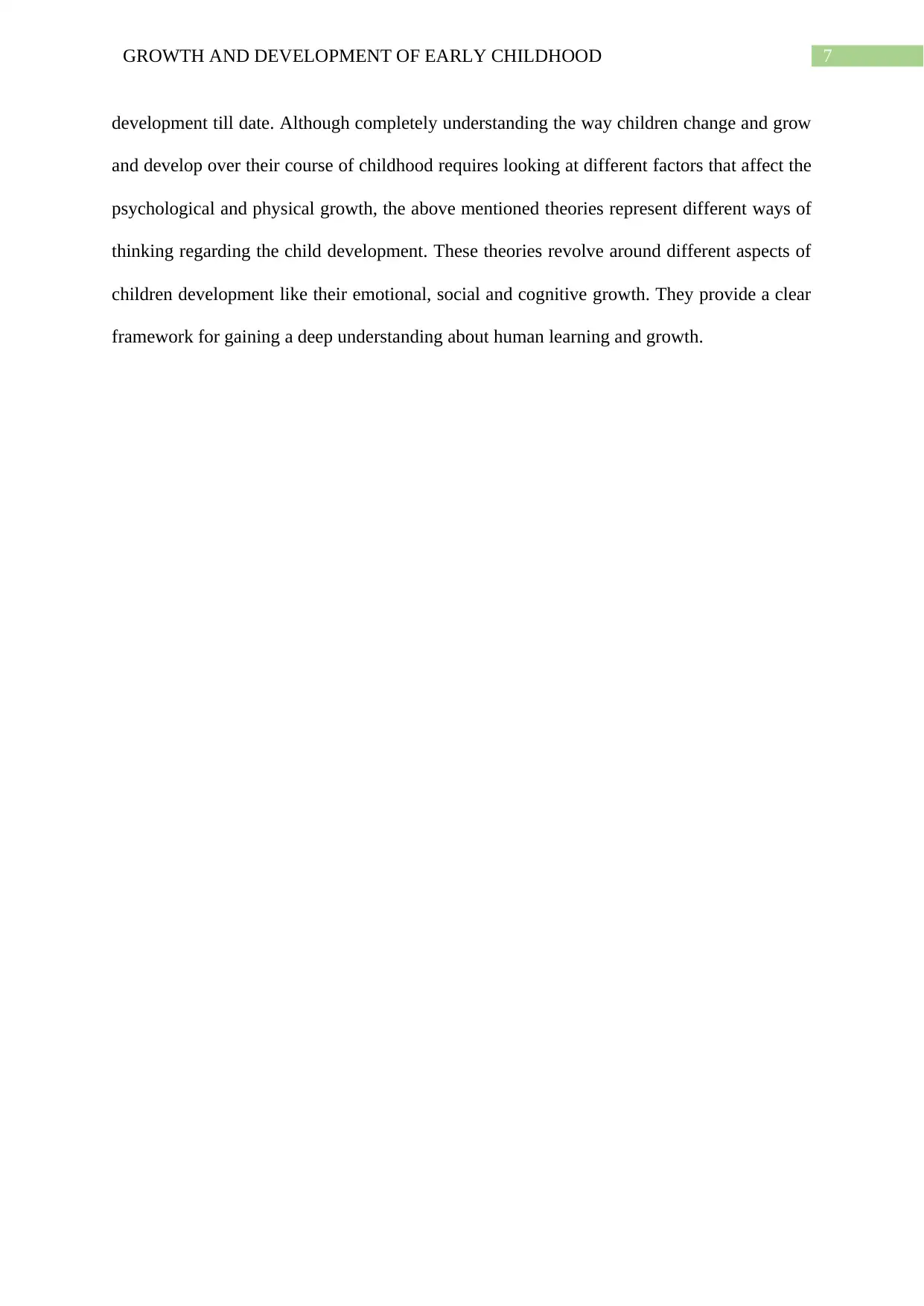
7GROWTH AND DEVELOPMENT OF EARLY CHILDHOOD
development till date. Although completely understanding the way children change and grow
and develop over their course of childhood requires looking at different factors that affect the
psychological and physical growth, the above mentioned theories represent different ways of
thinking regarding the child development. These theories revolve around different aspects of
children development like their emotional, social and cognitive growth. They provide a clear
framework for gaining a deep understanding about human learning and growth.
development till date. Although completely understanding the way children change and grow
and develop over their course of childhood requires looking at different factors that affect the
psychological and physical growth, the above mentioned theories represent different ways of
thinking regarding the child development. These theories revolve around different aspects of
children development like their emotional, social and cognitive growth. They provide a clear
framework for gaining a deep understanding about human learning and growth.
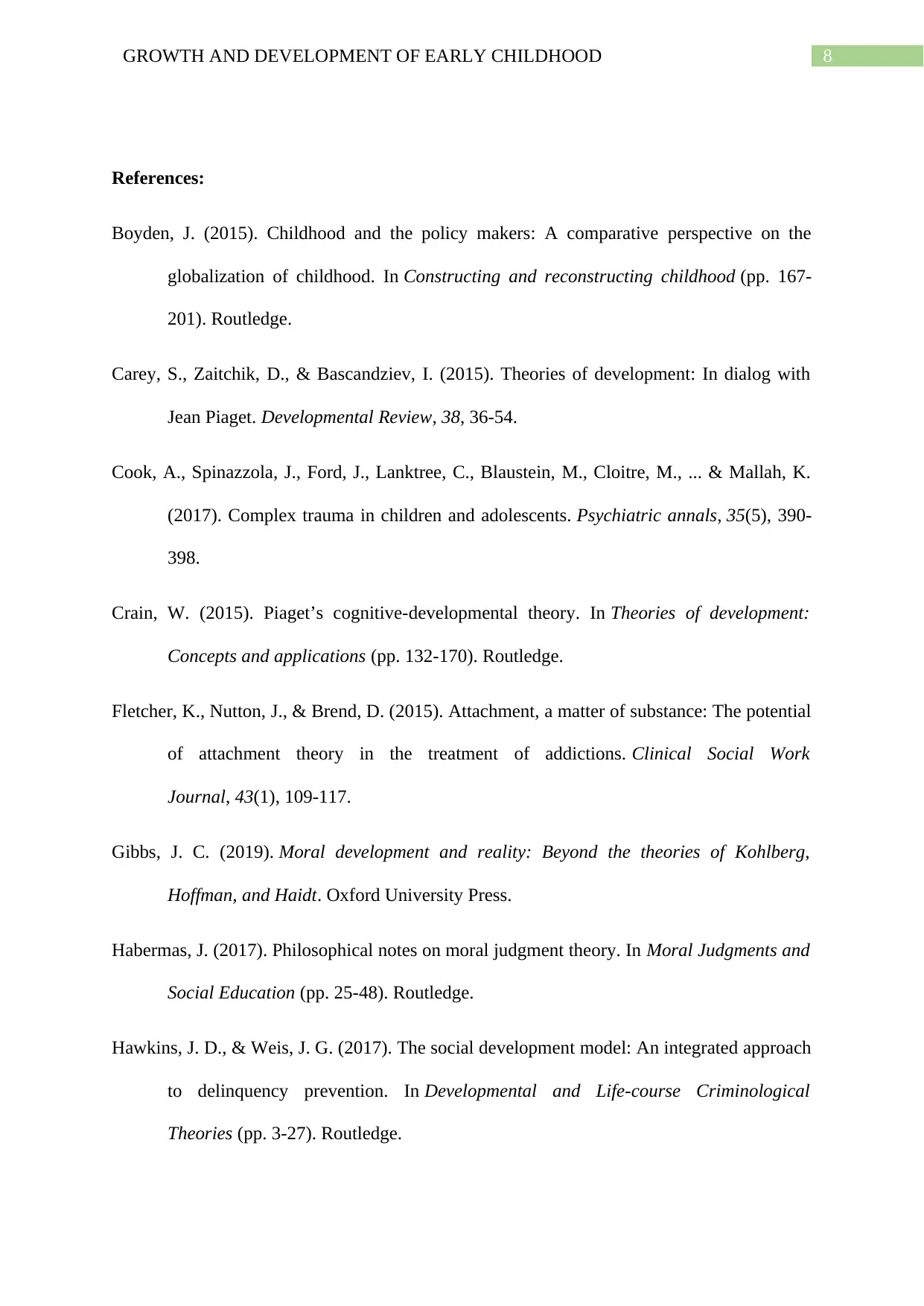
8GROWTH AND DEVELOPMENT OF EARLY CHILDHOOD
References:
Boyden, J. (2015). Childhood and the policy makers: A comparative perspective on the
globalization of childhood. In Constructing and reconstructing childhood (pp. 167-
201). Routledge.
Carey, S., Zaitchik, D., & Bascandziev, I. (2015). Theories of development: In dialog with
Jean Piaget. Developmental Review, 38, 36-54.
Cook, A., Spinazzola, J., Ford, J., Lanktree, C., Blaustein, M., Cloitre, M., ... & Mallah, K.
(2017). Complex trauma in children and adolescents. Psychiatric annals, 35(5), 390-
398.
Crain, W. (2015). Piaget’s cognitive-developmental theory. In Theories of development:
Concepts and applications (pp. 132-170). Routledge.
Fletcher, K., Nutton, J., & Brend, D. (2015). Attachment, a matter of substance: The potential
of attachment theory in the treatment of addictions. Clinical Social Work
Journal, 43(1), 109-117.
Gibbs, J. C. (2019). Moral development and reality: Beyond the theories of Kohlberg,
Hoffman, and Haidt. Oxford University Press.
Habermas, J. (2017). Philosophical notes on moral judgment theory. In Moral Judgments and
Social Education (pp. 25-48). Routledge.
Hawkins, J. D., & Weis, J. G. (2017). The social development model: An integrated approach
to delinquency prevention. In Developmental and Life-course Criminological
Theories (pp. 3-27). Routledge.
References:
Boyden, J. (2015). Childhood and the policy makers: A comparative perspective on the
globalization of childhood. In Constructing and reconstructing childhood (pp. 167-
201). Routledge.
Carey, S., Zaitchik, D., & Bascandziev, I. (2015). Theories of development: In dialog with
Jean Piaget. Developmental Review, 38, 36-54.
Cook, A., Spinazzola, J., Ford, J., Lanktree, C., Blaustein, M., Cloitre, M., ... & Mallah, K.
(2017). Complex trauma in children and adolescents. Psychiatric annals, 35(5), 390-
398.
Crain, W. (2015). Piaget’s cognitive-developmental theory. In Theories of development:
Concepts and applications (pp. 132-170). Routledge.
Fletcher, K., Nutton, J., & Brend, D. (2015). Attachment, a matter of substance: The potential
of attachment theory in the treatment of addictions. Clinical Social Work
Journal, 43(1), 109-117.
Gibbs, J. C. (2019). Moral development and reality: Beyond the theories of Kohlberg,
Hoffman, and Haidt. Oxford University Press.
Habermas, J. (2017). Philosophical notes on moral judgment theory. In Moral Judgments and
Social Education (pp. 25-48). Routledge.
Hawkins, J. D., & Weis, J. G. (2017). The social development model: An integrated approach
to delinquency prevention. In Developmental and Life-course Criminological
Theories (pp. 3-27). Routledge.
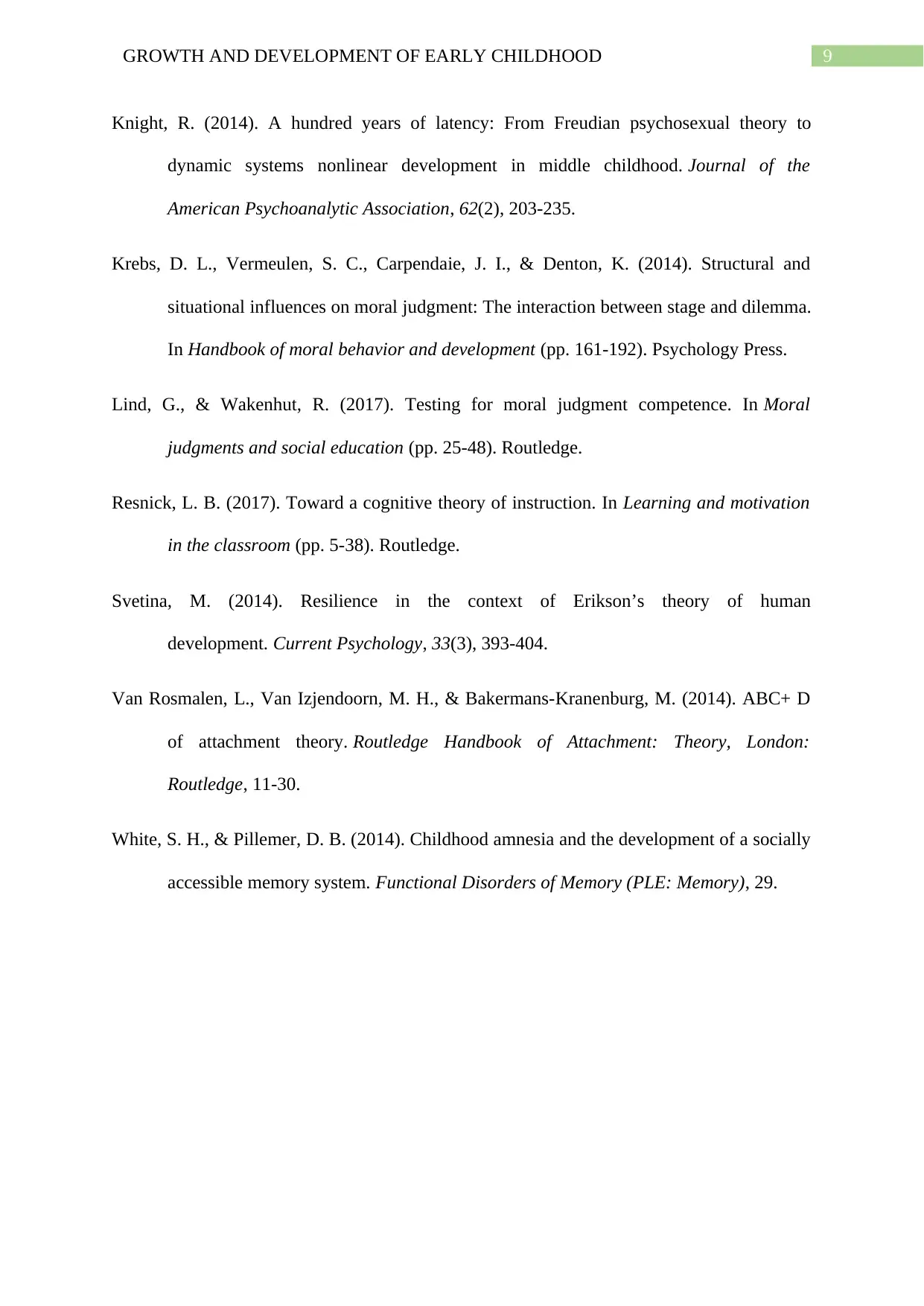
9GROWTH AND DEVELOPMENT OF EARLY CHILDHOOD
Knight, R. (2014). A hundred years of latency: From Freudian psychosexual theory to
dynamic systems nonlinear development in middle childhood. Journal of the
American Psychoanalytic Association, 62(2), 203-235.
Krebs, D. L., Vermeulen, S. C., Carpendaie, J. I., & Denton, K. (2014). Structural and
situational influences on moral judgment: The interaction between stage and dilemma.
In Handbook of moral behavior and development (pp. 161-192). Psychology Press.
Lind, G., & Wakenhut, R. (2017). Testing for moral judgment competence. In Moral
judgments and social education (pp. 25-48). Routledge.
Resnick, L. B. (2017). Toward a cognitive theory of instruction. In Learning and motivation
in the classroom (pp. 5-38). Routledge.
Svetina, M. (2014). Resilience in the context of Erikson’s theory of human
development. Current Psychology, 33(3), 393-404.
Van Rosmalen, L., Van Izjendoorn, M. H., & Bakermans-Kranenburg, M. (2014). ABC+ D
of attachment theory. Routledge Handbook of Attachment: Theory, London:
Routledge, 11-30.
White, S. H., & Pillemer, D. B. (2014). Childhood amnesia and the development of a socially
accessible memory system. Functional Disorders of Memory (PLE: Memory), 29.
Knight, R. (2014). A hundred years of latency: From Freudian psychosexual theory to
dynamic systems nonlinear development in middle childhood. Journal of the
American Psychoanalytic Association, 62(2), 203-235.
Krebs, D. L., Vermeulen, S. C., Carpendaie, J. I., & Denton, K. (2014). Structural and
situational influences on moral judgment: The interaction between stage and dilemma.
In Handbook of moral behavior and development (pp. 161-192). Psychology Press.
Lind, G., & Wakenhut, R. (2017). Testing for moral judgment competence. In Moral
judgments and social education (pp. 25-48). Routledge.
Resnick, L. B. (2017). Toward a cognitive theory of instruction. In Learning and motivation
in the classroom (pp. 5-38). Routledge.
Svetina, M. (2014). Resilience in the context of Erikson’s theory of human
development. Current Psychology, 33(3), 393-404.
Van Rosmalen, L., Van Izjendoorn, M. H., & Bakermans-Kranenburg, M. (2014). ABC+ D
of attachment theory. Routledge Handbook of Attachment: Theory, London:
Routledge, 11-30.
White, S. H., & Pillemer, D. B. (2014). Childhood amnesia and the development of a socially
accessible memory system. Functional Disorders of Memory (PLE: Memory), 29.
1 out of 10
Related Documents
Your All-in-One AI-Powered Toolkit for Academic Success.
+13062052269
info@desklib.com
Available 24*7 on WhatsApp / Email
![[object Object]](/_next/static/media/star-bottom.7253800d.svg)
Unlock your academic potential
© 2024 | Zucol Services PVT LTD | All rights reserved.





